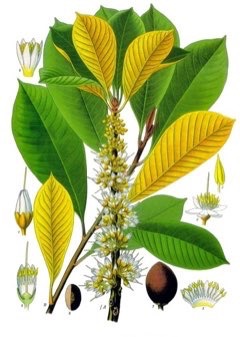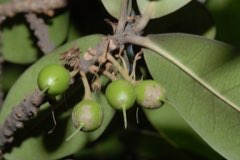 |
|
http://www.edibleplants.org |
 |
| LiChieh Pan flickr.com |
Translate this page:
Summary
Known for its latex, Gutta-Percha or Palaquium gutta is a tree found in Sumatra, Malaysia, Singapore, and Borneo.It grows up to 40 - 45 m in height. The bark is cracked and reddish brown. The leaves are thickly papery, oval, and have reddish-brown hairs underneath. The inflorescence is comprised of up to 12 flowers. The fruits are round or ellipsoidal. The seeds contain fat which can be used in cooking and in soap and candle making. There is no known medicinal uses of this plant but it is the main source of gutta-percha latex which has a wide range of uses such as insulting material, core of golf balls, tooth fillings, ornate furniture, jewelry, etc. The wood is used for planks, panelling, decorative doors, furniture, and veneer.
Physical Characteristics

 Palaquium gutta is an evergreen Tree growing to 20 m (65ft) by 20 m (65ft) at a fast rate.
Palaquium gutta is an evergreen Tree growing to 20 m (65ft) by 20 m (65ft) at a fast rate.
See above for USDA hardiness. It is hardy to UK zone 10.
Suitable for: light (sandy), medium (loamy) and heavy (clay) soils and prefers well-drained soil. Suitable pH: mildly acid, neutral and basic (mildly alkaline) soils. It cannot grow in the shade. It prefers moist soil.
UK Hardiness Map
US Hardiness Map
Synonyms
Croixia gutta (Hook.) Baehni Dichopsis borneensis (Burck) Fox Dichopsis gutta (Hook.) Benth. Dichops
Plant Habitats
Edible Uses
Edible Parts: Seed
Edible Uses:
The seeds contain a fat that is sometimes used for cooking[310 , 418 ].
References More on Edible Uses
Medicinal Uses
Plants For A Future can not take any responsibility for any adverse effects from the use of plants. Always seek advice from a professional before using a plant medicinally.
Odontalgic
None known
References More on Medicinal Uses
The Bookshop: Edible Plant Books
Our Latest books on Perennial Plants For Food Forests and Permaculture Gardens in paperback or digital formats.

Edible Tropical Plants
Food Forest Plants for Hotter Conditions: 250+ Plants For Tropical Food Forests & Permaculture Gardens.
More

Edible Temperate Plants
Plants for Your Food Forest: 500 Plants for Temperate Food Forests & Permaculture Gardens.
More

More Books
PFAF have eight books available in paperback and digital formats. Browse the shop for more information.
Shop Now
Other Uses
Furniture Insulation Latex Lighting Soap making Teeth Wood
Other Uses This species is the main source of gutta-percha[46 ]. Gutta-percha is a natural latex obtained from the sap of the tree. Allowing this fluid to evaporate and coagulate in the sun produces a hard, durable, non-brittle but non-elastic latex which can be made flexible again when heated to temperatures over 50°c, and then retains any form given while cooling. Prior to the advent of synthetic materials, gutta-percha had a wide range of uses - most particularly as an insulating material for electricity wiring and for underwater telegraph wires, a purpose for which it is very well suited since it is bio-inert and so is not attacked by marine plants or animals. Gutta-percha can be moulded into any shape and has been used to make items such as ornate furniture, pistol grips, acid-resistant receptacles and 'mourning' jewellery, where its dark colour was an advantage. It has been widely used as the core of golf balls and is still used in modern dentistry where its bio-inertness makes it ideal as a temporary filling for teeth and as a filling material inside tooth fillings[46 , 310 , 418 ]. It is used locally for fixing tools into their handles[310 ]. Leaves of about 10 months of age are considered to be the source of the best quality latex[310 , 418 ]. The seeds contain 58 - 63% fat used for the manufacture of soaps and candles[310 , 418 ]. The timber is used for planks that are not exposed to the weather or ground; for panelling; and for the manufacture of fine furniture, decorative doors and veneers[310 , 418 ]. We do not have any more specific information on the wood of this species, but it belongs to a group of timbers collectively called 'Nyatoh'[701 ]. The general description of nyatoh wood is as follows:- The heartwood is a dark pink to a red-brown; it is clearly demarcated from the 4 - 9cm wide band of sapwood. The texture is medium; the grain straight or interlocked, sometimes wavy. The wood is light in weight, soft to moderately hard; somewhat durable, being resistant to dry wood borers, moderately resistant to fungi but susceptible to termites. It seasons somewhat slowly, with a high risk of checking and distortion; once dry it is stable in service. There is a very variable content of silica according to the species, but in general the wood has a high blunting effect so stellite-tipped and tungsten-carbide tools are recommended; nailing and screwing are good, but require pre-boring; gluing is correct. The wood has a range of applications, including for highclass furniture and cabinet making, panelling, joinery, flooring, light carpentry, turnery, moulding and veneer[848 ].
Special Uses
References More on Other Uses
Cultivation details
Gutta percha is a plant of mainly lowland areas in the moist tropics, with or without a dry season, though it can be found at elevations up to 1,600 metres[418 ]. It grows best in areas where the mean annual temperature falls within the range 24 - 30°c, but can tolerate 17 - 38°c[418 ]. It prefers a mean annual rainfall in the range 2,000 - 3,000mm, tolerating 1,500 - 4,000mm[418 ]. Prefers a sunny position[418 ]. Grows best in a deep, fertile, well-drained soil[418 ]. Requires a loose and well aerated soil rich in organic matter[310 ]. Prefers a pH in the range 6 - 7, but tolerates 5.5 - 8[418 ]. In Peninsular Malaysia, trees have a mean annual diameter increment of 1.2 cm and attain a height of about 8 metres in 7 years, 17 metres in 23 years and a diameter of about 50 cm in 50 years[310 ]. Higher latex yields are obtained by tapping the upper portion of the trunk and branches than by tapping the lower part[310 ]. Yields of gutta-percha per tree are also very variable. About 1.5 kg was reported to be a good average yield for destructive harvesting. The latex yield obtained by tapping living trees is much lower. The approximate gutta-percha yield per ha was 450 kg (2.3% from treated leaves) in 1920; a recent estimate from the company exploiting the Cipetir plantation was only 20 kg/ha annually, probably because of the extensive way of exploitation nowadays[310 ].
References Carbon Farming Information and Carbon Sequestration Information
Temperature Converter
Type a value in the Celsius field to convert the value to Fahrenheit:
Fahrenheit:
The PFAF Bookshop
Plants For A Future have a number of books available in paperback and digital form. Book titles include Edible Plants, Edible Perennials, Edible Trees,Edible Shrubs, Woodland Gardening, and Temperate Food Forest Plants. Our new book is Food Forest Plants For Hotter Conditions (Tropical and Sub-Tropical).
Shop Now
Plant Propagation
Seed - best sown as soon as it is ripe since it loses its viability within 2 - 8 weeks[310 ]. Fresh seed has a germination rate of 75 - 85%[310 ]. Seed should be sown in deep nursery beds, as the seedlings quickly develop a strong taproot[310 ]. Young plants need shade and plenty of water, they grow quite rapidly and are ready for planting out when about 25 cm tall[310 ]. Mortality after planting out is usually high at up to 35%[310 ].
Other Names
If available other names are mentioned here
Gutta-Percha, gutta hang kang, gutta percha.
Native Range
TROPICAL ASIA: Indonesia (Jawa, Kalimantan, Sumatera), Malaysia, Singapore
Weed Potential
Right plant wrong place. We are currently updating this section.
Please note that a plant may be invasive in one area but may not in your area so it's worth checking.
Conservation Status
IUCN Red List of Threatened Plants Status : This taxon has not yet been assessed

Growth: S = slow M = medium F = fast. Soil: L = light (sandy) M = medium H = heavy (clay). pH: A = acid N = neutral B = basic (alkaline). Shade: F = full shade S = semi-shade N = no shade. Moisture: D = dry M = Moist We = wet Wa = water.
Now available:
Food Forest Plants for Mediterranean Conditions
350+ Perennial Plants For Mediterranean and Drier Food Forests and Permaculture Gardens.
[Paperback and eBook]
This is the third in Plants For A Future's series of plant guides for food forests tailored to
specific climate zones. Following volumes on temperate and tropical ecosystems, this book focuses
on species suited to Mediterranean conditions—regions with hot, dry summers and cool, wet winters,
often facing the added challenge of climate change.
Read More
Expert comment
Author
(Hook.) Baill.
Botanical References
Links / References
For a list of references used on this page please go here
A special thanks to Ken Fern for some of the information used on this page.
Readers comment
| Add a comment |
|
If you have important information about this plant that may help other users please add a comment or link below. Only comments or links that are felt to be directly relevant to a plant will be included. If you think a comment/link or information contained on this page is inaccurate or misleading we would welcome your feedback at [email protected]. If you have questions about a plant please use the Forum on this website as we do not have the resources to answer questions ourselves.
* Please note: the comments by website users are not necessarily those held by PFAF and may give misleading or inaccurate information.
To leave a comment please Register or login here All comments need to be approved so will not appear immediately.
|
Subject : Palaquium gutta
|
|
|
|